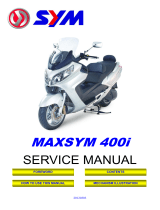
GENERAL
DESCRIPTION
ENGINE
OPERATING
SYSTEM
DESCRIPTION
The enginelgen.er.ator is equipped with an electronic speed-
regulated, fuel
Injected control system. Engine speed is
maintained constant by varying the amount
of
air induced
past a throttle plate into the intake manifold. The throttle
plate position is controlled by a rotary proportional actua-
tor energized from a closed loop control circuit whose
signal input is from a magnetic pickup-type speed sensor.
Fuel is metered to the engine intake manifold by a central
port-type fuel injector system where the amount
of
fuel
inj~ted
is primarily determined by the engine speed, the
engIne load, the engine temperature and the intake air
temperature. Fuel is delivered to the engine
by
a high
pressure fuel pump. The fuel pressure drop across the
inj,:"to~
is maintained
~onstant
by a fuel pressure regnlator
which IS ported to the Intake manifold to compensate for
pressure variations as a result
of
engine load changes.
Air-fuel management as well as engine operational functions
are performed by an embedded electronic control unit (ECU).
~nginelgenerator
control functions (starting and stopping) are
Inputted from a remote control panel
or
from the engine
STARf/OFF switch to the ECU. The ECU then sets the
required operational parameters necessary for the running
of
the engine.
THROTTLE
BODY
The throttle body, mounted
on
the intake manifold, is an
assembly
of
the principal components
of
the EFI
(Electronic Fuel Injection System).
The EFI is controlled by the
ECU (Electronic Control
Unit) which interprets data from sensors that monitor the
vital parts
of
the' engine. The ECU uses this continuous
flow
of
data to determine the appropriate injector pulse
rate and throttle opening position.
A high pressure fuel pump supplies fuel to the area around
the injector and the regnlator maintains the fuel pressure in
that area at 35 -
40
PSI.
The injector is a solenoid operated pintle valve that meters
fuel into the intake manifold depending on engine
operating conditions and generator amperage load as
determined by the
ECU.
Air flow into the intake manifold is through the flame
arresterlair filter and is controlled by the
ECU operation
of
the throttle plate via the actuator (stepper motor). The
~ottle
pla~e
positioning for proper air flow into the engine
IS accomphshed through the
ECU
interpretation
of
the
engine operating conditions. The Schrader valve is used to
monitor the fuel pressure at the fuel injector and to bleed
air after fuel system servicing.
On some models
an
air intake heater is positioned in the
intake to heat the incoming air during a cold start .
The output driver in the
ECU which controls the relays
(K~,
K2)
~d
the control panel indicator lamp(s) is one
which has Internal current limiting capability
of
its outputs
and will
turn itself
off
should such an over-current '
condition occur. Therefore, the engine
statUs
indicator
lamps are
of
the
l2V
LED type.
The ROM
of
the
MCU
contains the program from which
the engine is controlled. The
MCU
measures and monitors
the status
of
the engine through various inputs and then sets
accordingly the outputs which control the engine. The
MCU has direct control
of
the amount
of
the fuel injected
as well as some control
of
the throttle position. The actual
position
of
the throttle plate actuator for speed control how-
~ver,
is determined
by
a proportional, integral and deriva-
tIve (PID) analog closed loop control circuit. The
MCU
monitors the engine speed and will shut down the engine in
case an overspeed condition should ever occur.
In
addition, the
ECU has a safety backup overspeed circuit in the unlikely
event that the
MCU fails to respond.
This manual provides detailed testing procedures
of
the
operating system and its components including a
troubleshooting chatt and wiring schematics
of
four EFI
generators.
...v:
WESTERBEKE
Engines
&
Generators
2























